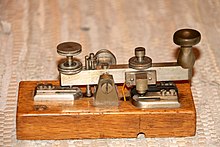
Back Morsekode Afrikaans Codigo Morse AN شفرة مورس Arabic كريپطة د مورس ARY ম'ৰ্চ ক'ড Assamese Códigu morse AST Morze əlifbası Azerbaijani Морзе алфавиты Bashkir Азбука Морзэ Byelorussian Азбука Морзэ BE-X-OLD


Morse code is a method used in telecommunication to encode text characters as standardized sequences of two different signal durations, called dots and dashes, or dits and dahs.[3][4] Morse code is named after Samuel Morse, one of the early developers of the system adopted for electrical telegraphy.
International Morse code encodes the 26 basic Latin letters A to Z, one accented Latin letter (É), the Arabic numerals, and a small set of punctuation and procedural signals (prosigns). There is no distinction between upper and lower case letters.[1] Each Morse code symbol is formed by a sequence of dits and dahs. The dit duration can vary for signal clarity and operator skill, but for any one message, once established it is the basic unit of time measurement in Morse code. The duration of a dah is three times the duration of a dit (although some telegraphers deliberately exaggerate the length of a dah for clearer signalling). Each dit or dah within an encoded character is followed by a period of signal absence, called a space, equal to the dit duration. The letters of a word are separated by a space of duration equal to three dits, and words are separated by a space equal to seven dits.[1][5][a]
Morse code can be memorized and sent in a form perceptible to the human senses, e.g. via sound waves or visible light, such that it can be directly interpreted by persons trained in the skill.[7][8] Morse code is usually transmitted by on-off keying of an information-carrying medium such as electric current, radio waves, visible light, or sound waves.[9][10] The current or wave is present during the time period of the dit or dah and absent during the time between dits and dahs.[11][12]
Since many natural languages use more than the 26 letters of the Latin alphabet, Morse alphabets have been developed for those languages, largely by transliteration of existing codes.[13]
To increase the efficiency of transmission, Morse code was originally designed so that the duration of each symbol is approximately inverse to the frequency of occurrence of the character that it represents in text of the English language. Thus the most common letter in English, the letter E, has the shortest code – a single dit. Because the Morse code elements are specified by proportion rather than specific time durations, the code is usually transmitted at the highest rate that the receiver is capable of decoding. Morse code transmission rate (speed) is specified in groups per minute, commonly referred to as words per minute.[b][7]
- ^ a b c Cite error: The named reference
ITU-R-M-1677was invoked but never defined (see the help page). - ^ Gotthard morse key used by shortwave radio amateur HB9BFM. Retrieved 25 September 2021.
- ^ Cite error: The named reference
Beechey-1876was invoked but never defined (see the help page). - ^ Cite error: The named reference
Camm-1941was invoked but never defined (see the help page). - ^ Telegraph Regulations (PDF) (Report). ITU History. Geneva, CH: International Telecommunication Union. 1949 [1947]. p. 42.
the space between two words is equal to seven dots;
— Annexed to the International Telecommunication Convention, Atlantic City, 1947; revised Paris, 1949. - ^ Telegraph Regulations (PDF) (Report). ITU History. Geneva, CH: International Telecommunication Union. 1938 [1932]. p. 39.
The space between two words is equal to five dots.
— Annexed to the International Telecommunication Convention, Madrid, 1932; revised Cairo, 1938. - ^ a b c Cite error: The named reference
Army-1968-TM-11-459was invoked but never defined (see the help page). - ^ Cite error: The named reference
Preece-Sivewright-1891was invoked but never defined (see the help page). - ^ Cite error: The named reference
Army-1939-FM-24-5was invoked but never defined (see the help page). - ^ Cite error: The named reference
Everitt-1937was invoked but never defined (see the help page). - ^ Cite error: The named reference
Radio-mag-Handbook-1940was invoked but never defined (see the help page). - ^ Cite error: The named reference
War-1943-TM-11-459was invoked but never defined (see the help page).
Cite error: There are <ref group=lower-alpha> tags or {{efn}} templates on this page, but the references will not show without a {{reflist|group=lower-alpha}} template or {{notelist}} template (see the help page).
© MMXXIII Rich X Search. We shall prevail. All rights reserved. Rich X Search